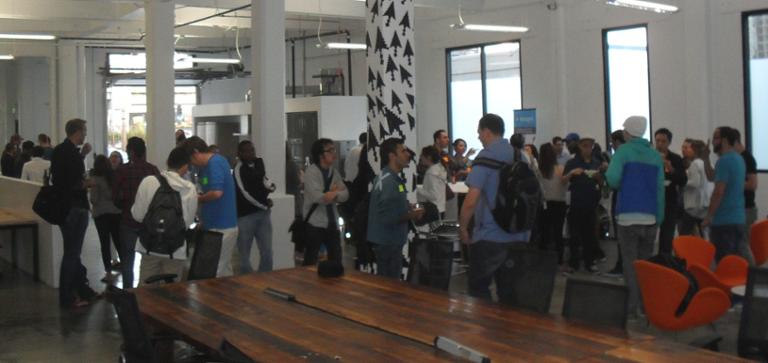Come a Lone Wolf, But Join A Pack
Apparently, Wee is not alone in that strategy. A number of other participants also came to the party solo looking for folks to potentially come together with to form a team for the two-day event. Eran Davidov, a former engineering director at Sun Microsystems and entrepreneur, did likewise for his debut into the hackathon world. "When I was at Sun, I was responsible for Java on mobile," Davidov says. "I wanted to come to this mobile game hackathon to network and because I like programming." [caption id="attachment_46902" align="aligncenter" width="1024"] L-R: Eran Davidov, Angelo Hizon and Phil Wee[/caption] Networking is key to survival at a hackathon. Solo participants need to find the right mix of talent to complement their strengths. "When I came here, I didn't know anyone," Davidov says. "I have to go and say hello to at least 10 people. It forces me to get out of myself. As a kid, I was the one on the playground who would read a book, so no one would bother me." Wee agrees, noting most developers tend to be shy and are forced to socialize at hackathons. While this skill is not necessarily transferable when it comes to hanging out at parties or bars, Wee says it does help when you have to team up with project members you've never met.
L-R: Eran Davidov, Angelo Hizon and Phil Wee[/caption] Networking is key to survival at a hackathon. Solo participants need to find the right mix of talent to complement their strengths. "When I came here, I didn't know anyone," Davidov says. "I have to go and say hello to at least 10 people. It forces me to get out of myself. As a kid, I was the one on the playground who would read a book, so no one would bother me." Wee agrees, noting most developers tend to be shy and are forced to socialize at hackathons. While this skill is not necessarily transferable when it comes to hanging out at parties or bars, Wee says it does help when you have to team up with project members you've never met.
Rules and Them Regulations
Back to the hackathon. Here's what Chartboost says hackers face once they begin their 30-hour odyssey that begins at 1 pm PST today:
- All game code and content must be created during the hackathon. We will ask to upload your source code to GitHub so we can verify it.
- Game must be native mobile app or be accessible and playable via mobile web browser.
- All publicly available libraries, APIs, and SDKs are allowed.
- All content creation and development tools are allowed
"This hackathon has virtually no guidelines compared to the Google TV one I entered recently. You had to use their APIs and it had to be a children's game. I'm a designer, so I followed what the coders wanted done," says Angelo Hizon, a 3D game designer whose day job is working at a vocational institute for people with disabilities. Hizon is a hackathon machine. He's entered more than a dozen hackathons over the past few years and walked away with awards. In this current hackathon, Hizon says he plans to use his own IP, since Chartboost's guidelines allow for it. Pepe Agell, head of business development for Chartboost, says if participants want to ride the latest trend in mobile games they should look at building a free-to-play game that allows users pay a premium for resources, rather than design an advertising-supported free version and an accompanying premium version.
A three-panel judge will size up the mobile games based on innovation, fun, graphics, gameplay and vitality. But hackathon judge Sean Fannan, Chartboost co-founder and head of its engineering team, says the big goal to shoot for is presenting a game that's complete and works. "We'll be looking at technical difficulty, creativity, how fun it is and the presentation of the demo," Fannan says. "Teams that have a less functional game tend to be more about the presentation, whereas teams that have a functional game just show it and talk less." [caption id="attachment_46906" align="aligncenter" width="1024"]Judge and Jury
 L-R: Sean Fannan, Chartboost co-founder and hackathon judge talks to an event spectator[/caption] Part of the fun factor in being a judge is to see what teams come together following the launch party. At a minimum, a team needs a designer and someone to code but often teams as large as five people form, Fannan says. "A team of two people who can make a functioning game in 30 hours is hard," says Fannan. "If they can do it, they're a rock star."
L-R: Sean Fannan, Chartboost co-founder and hackathon judge talks to an event spectator[/caption] Part of the fun factor in being a judge is to see what teams come together following the launch party. At a minimum, a team needs a designer and someone to code but often teams as large as five people form, Fannan says. "A team of two people who can make a functioning game in 30 hours is hard," says Fannan. "If they can do it, they're a rock star." 
